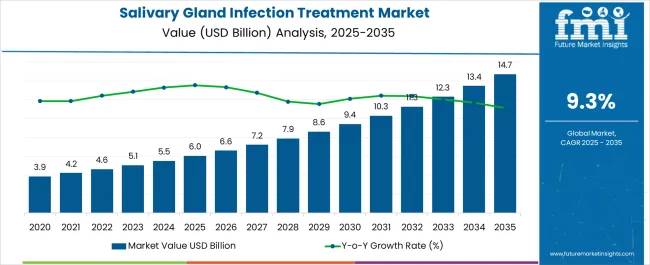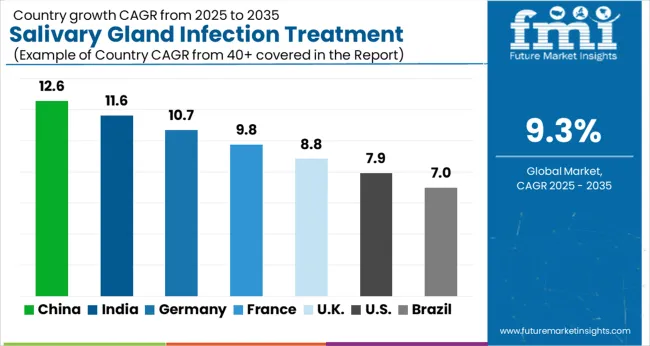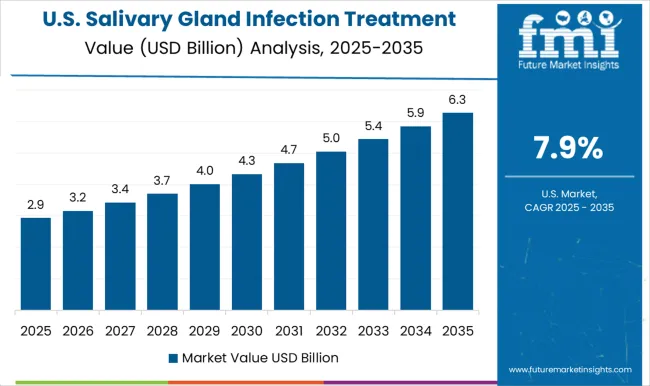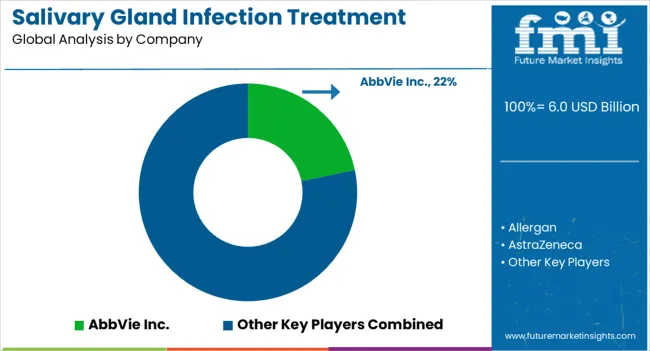The Salivary Gland Infection Treatment Market is estimated to be valued at USD 6.0 billion in 2025 and is projected to reach USD 14.7 billion by 2035, registering a compound annual growth rate (CAGR) of 9.3% over the forecast period.

| Metric | Value |
|---|---|
| Salivary Gland Infection Treatment Market Estimated Value in (2025 E) | USD 6.0 billion |
| Salivary Gland Infection Treatment Market Forecast Value in (2035 F) | USD 14.7 billion |
| Forecast CAGR (2025 to 2035) | 9.3% |
The salivary gland infection treatment market is expanding due to the growing prevalence of bacterial and viral infections, rising incidence of salivary gland disorders, and increasing demand for advanced diagnostic imaging. Early detection has become a priority as untreated infections can lead to complications including abscesses and chronic conditions.
Technological advancements in imaging and diagnostic tools have enhanced the accuracy of identification, while the availability of multiple therapeutic options such as medications and minimally invasive procedures has improved treatment outcomes. Rising patient awareness, greater access to healthcare services, and the growing presence of specialized hospital pharmacies are further accelerating market adoption.
The future outlook is favorable as healthcare systems emphasize effective treatment pathways, optimized drug delivery, and reliable diagnostic approaches to reduce the burden of salivary gland-related infections.
The MRI diagnosis segment is expected to account for 47.60% of market revenue by 2025, making it the leading diagnostic method. MRI provides high resolution imaging and precise visualization of soft tissues, which is critical for identifying the location and extent of infections in salivary glands.
Its non invasive nature, combined with accuracy in detecting obstructions and abscesses, has made MRI the preferred diagnostic approach.
Increasing physician reliance on MRI for complex cases and growing patient preference for advanced imaging methods are contributing to its continued dominance within the diagnosis category.
The medication treatment segment is projected to represent 54.30% of total revenue by 2025 under the treatment category, positioning it as the most prominent therapeutic approach. This growth is being driven by the wide availability of antibiotics, antivirals, and supportive drugs that provide effective relief with minimal invasiveness.
Medications are often the first line of treatment due to their affordability, accessibility, and quick action in reducing infection and inflammation. The segment has also benefited from continuous advancements in targeted therapies and drug formulations that improve patient compliance.
As a result, medications remain the cornerstone of salivary gland infection management, reinforcing their leadership in the treatment category.
The hospital pharmacy segment is projected to contribute 42.80% of overall revenue by 2025 within the distribution channel category, making it the leading segment. Hospital pharmacies are preferred due to their direct integration with diagnostic and treatment services, enabling immediate access to prescribed medications.
They ensure better monitoring of drug administration, patient counseling, and adherence to treatment regimens. The trust associated with hospital-based dispensing and the rising number of hospital visits for infection treatment further strengthen this segment’s position.
With growing healthcare infrastructure and rising hospital admissions for salivary gland disorders, hospital pharmacies continue to dominate as the primary distribution channel.
According to market research and competitive intelligence provider Future Market Insights- the market for Salivary gland infection treatment reflected a value of 5% during the historical period, 2020 to 2025.
Research in the area of salivary gland infection treatment is ongoing, with a focus on developing more effective therapies and improving surgical techniques. Additionally, there is a growing interest in the use of alternative therapies, such as acupuncture and herbal medicine, for the management of salivary gland infections. Furthermore, key players in the market are focusing on innovating medication to offer various medications depending on the nature of the ailment.
Thus, the market for Salivary gland infection treatment is expected to register a CAGR of 9.3% in the forecast period 2025 to 2035.
Importance of oral hygiene driving salivary gland infection treatment market growth
The salivary gland infection treatment market is primarily driven by factors such as the increasing prevalence of salivary gland infections, the rising geriatric population, the growing awareness about the importance of oral hygiene, and the availability of various treatment options.
Other factors that are expected to contribute to market growth include advancements in diagnostic techniques, the increasing adoption of minimally invasive procedures, and the rising demand for personalized medicine. Additionally, the development of novel therapeutics and the increasing focus of key players on research and development activities are expected to create new opportunities for growth in the salivary gland infection treatment market.
Availability of treatments boosting market growth of salivary gland infection treatment
Antibiotics: If the infection is caused by bacteria, antibiotics are typically prescribed to treat the infection. The type of antibiotic used depends on the specific bacteria causing the infection. The course of antibiotics may last for several days to a few weeks, depending on the severity of the infection.
Pain relievers: Pain relievers such as acetaminophen or ibuprofen can help manage pain and inflammation associated with salivary gland infection.
Warm compresses: Applying a warm compress to the affected area can help reduce pain and swelling. The warmth helps to increase blood flow to the area and promote healing.
Sialagogues: These are medications that stimulate the production and flow of saliva. Sialagogues are sometimes prescribed to help clear blockages in the salivary gland duct and promote the flow of saliva, which can help flush out the infection.
Surgery: In severe cases, surgery may be required to drain an abscess or remove a stone that's blocking the salivary gland duct. Surgery may also be necessary if the infection is caused by a tumor.
Limited awareness and expensive treatment derailing growth of salivary gland infection treatment market
Salivary gland infections are often misdiagnosed or underdiagnosed due to their relatively uncommon nature and nonspecific symptoms. This can delay treatment and result in more serious complications. Antibiotics and other medications used to treat salivary gland infections can have side effects, which can impact patient compliance and satisfaction.
Limited awareness about salivary gland infections and their treatments, especially in developing countries, can limit access to appropriate care and delay treatment. While antibiotics are effective against bacterial infections, there are currently no specific antiviral drugs available to treat viral salivary gland infections.
The cost of treatment for salivary gland infections can be high, which may limit access to care for some patients. The overuse and misuse of antibiotics can contribute to the development of antibiotic-resistant bacteria, which can make treatment more difficult and less effective.


Increasing prevalence of infections propelling market growth in North America
The North America salivary gland infection treatment market is a significant segment of the global salivary gland infection treatment market. The region comprises of the USA, Canada, and Mexico. The market is driven by several factors such as the increasing prevalence of salivary gland infections, the availability of advanced healthcare infrastructure, and the presence of key players in the region.
The USA is the largest market in the region, owing to the high incidence of salivary gland infections and the growing awareness about oral hygiene. The increasing geriatric population and the rising demand for minimally invasive procedures are also contributing to market growth. Additionally, the presence of major pharmaceutical companies in the region, which are engaged in research and development activities to develop new and advanced treatment options, is expected to boost market growth.
Canada is also a significant market for salivary gland infection treatment, with increasing healthcare expenditure and rising awareness about oral hygiene. The presence of major medical device companies and the growing demand for minimally invasive procedures are also expected to contribute to market growth in the country.
Overall, the North America salivary gland infection treatment market is expected to experience steady growth over the coming years, driven by the increasing prevalence of salivary gland infections, the availability of advanced healthcare infrastructure, and the presence of key players in the region. Thus, North America is expected to possess 49% market share for salivary gland infection treatment market in 2025.
Advanced treatment options supporting growth of salivary gland infections treatment market in Europe
The Europe salivary gland infection treatment market is a significant segment of the global salivary gland infection treatment market. The region comprises of major countries such as Germany, France, the United Kingdom, Italy, Spain, and other European countries. The market is driven by several factors such as the high prevalence of salivary gland infections, increasing geriatric population, and rising awareness about oral hygiene.
Germany is the largest market in the region, owing to the increasing prevalence of salivary gland infections and the availability of advanced healthcare infrastructure. The country is also a leading manufacturer of medical devices, which is expected to contribute to the development of new and advanced treatment options.
The United Kingdom, France, Italy, and Spain are also significant markets for salivary gland infection treatment, driven by factors such as increasing healthcare expenditure, rising awareness about oral hygiene, and the growing geriatric population. Additionally, the presence of major pharmaceutical companies in the region is expected to boost market growth. Thus, Europe is expected to possess 43% market share for salivary gland infection treatment market in 2025.
Availability of painkillers and oral antibiotics making medication easy for salivary gland infection treatment
Antibiotics are often prescribed to treat bacterial salivary gland infections, as they can effectively kill the bacteria causing the infection. They are also widely available, and many patients can be treated with a simple course of oral antibiotics. In addition, over-the-counter painkillers such as acetaminophen or ibuprofen can be used to reduce pain and inflammation.
Medication can also help relieve other symptoms of salivary gland infections, such as fever, swelling, and difficulty swallowing. Salivary gland infections caused by viruses, such as mumps, do not have specific treatments. As a result, symptom relief and supportive care, such as rest and hydration, are the mainstay of treatment for viral salivary gland infections.
Medication is a non-invasive treatment option, which is particularly important for patients who may not be candidates for surgery or who wish to avoid surgical intervention. Thus, by treatment, medication is expected to possess 55% market share for gland infection treatment market in 2025.

Key players in the salivary gland infection treatment market are AbbVie Inc., Allergan, AstraZeneca, FUJIFILM Holdings Corporation, GlaxoSmithKline plc., Johnson & Johnson Services, Merck & Co., Inc., Pfizer Inc., Siemens Healthcare GmbH and Novartis AG
| Report Attribute | Details |
|---|---|
| Market Value in 2025 | USD 6.0 billion |
| Market Value in 2035 | USD 14.7 billion |
| Growth Rate | CAGR of 9.3% from 2025 to 2035 |
| Base Year for Estimation | 2025 |
| Historical Data | 2020 to 2025 |
| Forecast Period | 2025 to 2035 |
| Quantitative Units | Revenue in USD Million and CAGR from 2025 to 2035 |
| Report Coverage | Revenue Forecast, Volume Forecast, Company Ranking, Competitive Landscape, Growth Factors, Trends and Pricing Analysis |
| Segments Covered | Diagnosis, Treatment, Distribution Channel, End User, Region |
| Regions Covered | North America; Latin America; Europe; South Asia; East Asia; Oceania; MEA |
| Key Countries Profiled | USA, Canada, Brazil, Mexico, Rest of Latin America, Germany, United Kingdom, France, Spain, Italy, Rest of Europe, India, Malaysia, Singapore, Thailand, Rest of South Asia, China, Japan, South Korea, Austria, New Zealand, GCC countries, South Africa, Israel, Rest of MEA |
| Key Companies Profiled | AbbVie Inc.; Allergan; AstraZeneca; FUJIFILM Holdings Corporation; GlaxoSmithKline plc.; Johnson & Johnson Services; Merck & Co., Inc.; Pfizer Inc.; Siemens Healthcare GmbH; Novartis AG |
| Customization | Available Upon Request |
The global salivary gland infection treatment market is estimated to be valued at USD 6.0 billion in 2025.
The market size for the salivary gland infection treatment market is projected to reach USD 14.7 billion by 2035.
The salivary gland infection treatment market is expected to grow at a 9.3% CAGR between 2025 and 2035.
The key product types in salivary gland infection treatment market are mri, ct scan, pet scan, endoscopy and biopsy.
In terms of treatment, medication segment to command 54.3% share in the salivary gland infection treatment market in 2025.






Our Research Products

The "Full Research Suite" delivers actionable market intel, deep dives on markets or technologies, so clients act faster, cut risk, and unlock growth.

The Leaderboard benchmarks and ranks top vendors, classifying them as Established Leaders, Leading Challengers, or Disruptors & Challengers.

Locates where complements amplify value and substitutes erode it, forecasting net impact by horizon

We deliver granular, decision-grade intel: market sizing, 5-year forecasts, pricing, adoption, usage, revenue, and operational KPIs—plus competitor tracking, regulation, and value chains—across 60 countries broadly.

Spot the shifts before they hit your P&L. We track inflection points, adoption curves, pricing moves, and ecosystem plays to show where demand is heading, why it is changing, and what to do next across high-growth markets and disruptive tech

Real-time reads of user behavior. We track shifting priorities, perceptions of today’s and next-gen services, and provider experience, then pace how fast tech moves from trial to adoption, blending buyer, consumer, and channel inputs with social signals (#WhySwitch, #UX).

Partner with our analyst team to build a custom report designed around your business priorities. From analysing market trends to assessing competitors or crafting bespoke datasets, we tailor insights to your needs.
Supplier Intelligence
Discovery & Profiling
Capacity & Footprint
Performance & Risk
Compliance & Governance
Commercial Readiness
Who Supplies Whom
Scorecards & Shortlists
Playbooks & Docs
Category Intelligence
Definition & Scope
Demand & Use Cases
Cost Drivers
Market Structure
Supply Chain Map
Trade & Policy
Operating Norms
Deliverables
Buyer Intelligence
Account Basics
Spend & Scope
Procurement Model
Vendor Requirements
Terms & Policies
Entry Strategy
Pain Points & Triggers
Outputs
Pricing Analysis
Benchmarks
Trends
Should-Cost
Indexation
Landed Cost
Commercial Terms
Deliverables
Brand Analysis
Positioning & Value Prop
Share & Presence
Customer Evidence
Go-to-Market
Digital & Reputation
Compliance & Trust
KPIs & Gaps
Outputs
Full Research Suite comprises of:
Market outlook & trends analysis
Interviews & case studies
Strategic recommendations
Vendor profiles & capabilities analysis
5-year forecasts
8 regions and 60+ country-level data splits
Market segment data splits
12 months of continuous data updates
DELIVERED AS:
PDF EXCEL ONLINE
Glandular Ingredients Market Size and Share Forecast Outlook 2025 to 2035
Treatment-Resistant Hypertension Management Market Size and Share Forecast Outlook 2025 to 2035
Treatment-Resistant Depression Treatment Market Size and Share Forecast Outlook 2025 to 2035
Treatment Pumps Market Insights Growth & Demand Forecast 2025 to 2035
Pretreatment Coatings Market Size and Share Forecast Outlook 2025 to 2035
Air Treatment Ozone Generator Market Size and Share Forecast Outlook 2025 to 2035
CNS Treatment and Therapy Market Insights - Trends & Growth Forecast 2025 to 2035
Seed Treatment Materials Market Size and Share Forecast Outlook 2025 to 2035
Acne Treatment Solutions Market Size and Share Forecast Outlook 2025 to 2035
Scar Treatment Market Overview - Growth & Demand Forecast 2025 to 2035
Soil Treatment Chemicals Market
Water Treatment System Market Size and Share Forecast Outlook 2025 to 2035
Water Treatment Chemical Market Size and Share Forecast Outlook 2025 to 2035
Algae Treatment Chemical Market Forecast and Outlook 2025 to 2035
Water Treatment Market Size and Share Forecast Outlook 2025 to 2035
Water Treatment Ozone Generator Market Size and Share Forecast Outlook 2025 to 2035
Water Treatment Equipment Market Size and Share Forecast Outlook 2025 to 2035
Burns Treatment Market Overview – Growth, Demand & Forecast 2025 to 2035
CRBSI Treatment Market Insights - Growth, Trends & Forecast 2025 to 2035
Water Treatment Polymers Market Growth & Demand 2025 to 2035

Thank you!
You will receive an email from our Business Development Manager. Please be sure to check your SPAM/JUNK folder too.
Chat With
MaRIA